Let's talk...
About the child’s feelings: We can read the story with our children several times. We then follow the illustrations and discuss them as an expressive panel and talk about the feelings of both the child and the grandfather during their joint activities.
About the relationship with the grandfather: We can talk to our child about the things he loves about his grandfather and grandmother, and the things that sometimes bother him.
About family relationships: The book presents the child’s experience of spending enjoyable time with her grandfather. We can talk to our children about the shared activities that our children love to do with their grandparents, aunts, uncles, and extended family.
Let's create...
Let’s prepare an album of the most beautiful moments with family members and relatives.
Let’s plan and create a house for our favourite pet with the help of grandparents.
Let's communicate...
Let’s visit our grandparents and initiate a fun activity together, such as gardening, going for a nature walk, playing chess, and more.
Let’s talk...
About the problem: in our first reading, and before we reach the solution, we should ask our child the following: the mother asked Alfie to find the solution to his problem, “How could he get the cake in a better way?” What do you suggest he should do? We can continue reading and ask our child again, what are the solutions suggested by Alfie? And what is the appropriate solution?
About our feelings: We can trace the drawings and talk about Alfie’s feelings. We can ask our children: How did Alfie feel when he saw his mother making cakes? How did he feel when she refused to give him the cake and asked him to think of a way to get it? How did he feel when he couldn’t find the solution? How did he feel at the end of the story?
About our attempts: Alfie tried several times and various ways to reach the solution. We can ask our children: Have you ever tried to get something or do something numerous times? How many times have you tried? When do we feel discouraged? how many trials does it take before we give up? What do we do when we are frustrated?
About problem solving: We can have a conversation with our child about similar situations in which they must find solutions to situations or problems. We can ask them: Did you encounter a problem? what is it? How did you feel? How many times have you tried? How did you find the solution? Who helped you? If you didn’t find a solution, how did you feel? How did you deal with the feeling of frustration?
Interaction between mother and child: The mother prepares cakes for Alfie and the rest of the family. We can talk with our child about what is happening in our home: What are the things that the mother and father do for us? What are the things you like to do together?
Life and social situations: Alfie’s mother portrayed an advanced model for dialogue and for giving and taking, by demonstrating it in her behaviour. We can have a conversation with our child about what is happening in our home. We can ask them: What happens when you do something different from what our mother or father wants? How do you behave? How would you like them to talk to you?
Let’s communicate...
We can spend quality time together with our child, preparing a cake, or preparing a communal meal.
Let’s enrich our language...
Our story contains emotional, mental, and social words, such as: to love; to desire; frustrated; thought; an idea occurred to him; an idea popped into his head; thanks; please; sorry. We should use these words in everyday context.
Let’s act and create...
We can choose different social situations, and with our children, we can familiarize ourselves with mild expressions that are appropriate for these situations. Together, we can act out the appropriate behaviour and use the appropriate social expressions – for example: a birthday party; visit to a patient; an apology; entertaining a guest; being a guest; when we need help…
We can discuss...
About the title: We can discuss the title of the story “The Cow that Laid an Egg,” and we can ask the children: Does the cow lay eggs?
We can ask...
About the concept of the unique and the special: We can ask the children: What is meant by unique and special? What are things that are common and normal? What are the special things that distinguish us and that we do differently? When do we feel special? Has anyone given us that feeling? Do we do things that make others feel special?
About trickery...
About trickery: The chickens used a trick to support the cow. What is the trick? Why did the chickens use it? What did the characters in the story think about it, and how did each of them feel? We can follow the drawings and talk about them. We can ask the children: Did they ever use a trick? How? Why? How did they feel?
A Fun night...
“A Fun night” – we can arrange a family session, grab a book of jokes, laugh and have fun together. We can also come up with some funny jokes and stories.
We can write...
We can write a funny book adapting the collage style by using newspaper clippings and colors to create funny scenes, such as sticking a chicken’s head on a cat’s body – for example.
We can browse...
We can browse the encyclopedia, or the Internet, and search for different animal species and how they breed.
We can look...
We can look for videos showing the stages of egg hatching. We can watch it and talk about it with the kids.
Let’s have a conversation...
About the different points of view: We can follow the arguments of the ferret and the bear and compare their points of view on why each is entitled to the third piece of mushroom. We can ask our children why the ferret thinks that he deserves the third mushroom, what the bear thinks, what the fox did, and how they felt then. We can even suggest a solution to their problem.
About justice: the ferret and the bear both mentioned the word “justice” in their arguments. What does justice mean? When did you feel injustice? What does it mean to act justly?
About tasks in the family: The bear and the ferret shared errands in their house. With our child, we can discuss the division of tasks within the family and the roles of each individual.
About sharing: Both the bear and the ferret found it difficult to share the third mushroom. We can talk with our child about the things they share with others, and about other things that are difficult for them to do. For example, how do they feel if they share a game they like with their friend or sibling?
About spending time together: We can talk about things we do in our family to show our love and concern for each other, such as sharing household chores, preparing a favourite meal, or doing a fun family tradition.
About argument and persuasion: We can choose a topic with our child, and we can discuss it from both sides, the argument and the counterargument, in order to develop our child’s ability to think and express themselves. For example: holding a birthday party, going on a journey, buying a new game – or any other topic of our choosing.
Let’s act...
We can choose a situation in which our child finds it difficult to participate. We can take turns and act it out. Then, we can talk about the feelings and desires of each one of us, about the difficulties we faced and suggest ways to deal with them. We can support our child and show them that sharing means caring for the other and showing their affection for this person.
Let’s create...
The ferret prepared a delicious meal of mushrooms in the story. We can prepare a shared meal with our children and prepare it together. We might also want to explore berry-based recipes.
Let’s have a conversation...
-About ways of expressing love: The girl expressed her love for her mother by surprising her and making biscuits for her. We can talk with our child about ways to express love, and we ask them: How can we express our love for the other? We can suggest several ways, such as expressing love with words or cards, or with body language such as hugs and giving kisses, or with actions such as helping and preparing surprises, as the girl did.
-About sympathy: the child was very sensitive to her mother and sympathized with her, so she did not want to wake her from her sleep. We can talk to our child and ask them how the mother feels about this behavior, and we can also ask them: How is it possible for the mother to be sensitive and sympathetic to the child? And how can a child be so towards the parents? We can give examples from our lives.
-About initiative: the girl took the initiative to prepare biscuits for her mother. The mother appreciated her child’s attempt and praised her. We can talk about the initiatives that our child has taken for the other (for example: for members of their family), or the initiatives that they can generally take for the other. We can also deal with their feelings and the feelings of the other. We should praise and encourage them.
-About flexibility and dealing with problems: Although the child made playdough instead of biscuits, the mother did not get angry or complain, on the contrary; She encouraged her and explained her she made playdough. We can talk with our child about experiences that did not go as we wanted or expected. How did they feel? How did they act? How did the parents act? How did we react?
-About surprises: Children love surprises and enjoy receiving and preparing surprises for their parents. You may want to decide with your child to prepare mutual surprises; Like making them a favorite dessert or inviting someone they love to your house.
Let’s share...
-We can prepare a cookie with our child, or a plate of salad. We can share the process of preparation together. We can also name the objects and the verbs. we taste; touch, have fun together.
Let’s talk...
-About reality and fiction: We can browse the book with our child and think about the drawings. We can then ask our child to guess: Which object did the box turn into each time? We can ask our child if they think Rabbit really believed that the box is a spacecraft, a robot or a mountain.
-About the color of drawings and about voices: The book contains two voices; The voice of the adult clinging to reality, and the voice of the creative child. The two voices are featured through the different colors of the drawings. We can trace the book’s drawings, paying attention to their colors, and try to distinguish between those that Rabbit imagines and creates, and those that speak to him, and we can ask the child why they think the painter chose to color these pages.
-About childhood toys: We can share our memories of the toys we made and the things we turned into toys with our children, and we can ask them about the toys they like and enjoy.
Let’s play...
-Let’s imagine and guess! We can sit in a group, and in turn, each one has to “act out” an object (cup; cat; lion; hammer), and the others have to guess what the object is, and so on (you can also time the game).
-The magic of imagination: We can prepare various objects (a hat, a cooker, a scarf…) and find many uses for each of them, or we can imagine them as other objects, like Rabbit did.
Let’s create...
-Imagination Box: with our children, we can get a box and simple materials, and we can build a spacecraft, a robot, or any idea that comes to our mind, from the pages of the book or from our imagination.
-The “this is not” book: We can write a new book with our child that draws from the idea of this book, such as: “This is not a line” or “This is not a cloud.” Let’s think and create!
Review with the child...
Review with the child the sequence of events before and after the cat showed up in the kitchen. Discuss the feelings of the mice in the two periods: what has changed?
Observe the little...
Observe the little details in the book’s drawings: which elements convey an atmosphere of joy and security that prevailed before the cat appears, and which of them convey an atmosphere of fear and caution after the opponent enters?
Mother Mouse...
Mother Mouse warns her little ones and prevents them from entering the kitchen. Discuss with your child the motives of Mother Mouse. You can choose a similar situation that the child encounters in the family or kindergarten environments. Why do adults sometimes prevent children from doing certain things?
The mice family...
The mice family gather to discuss the problem of the cat. Imagine that you become tiny and enter the mice hole and listen to their argument. Which family member participates in the argument? How the decision to hang a bell around the cat’s neck is taken? Discuss decision-making methods in matters that relate to your family life, such as going on a trip, or making improvements around the house, etc.)
Ask your child...
Ask your child, “who will hang the bell?” and encourage him/her to think of a solution to help the mice.
Where do houses hide?...
Where do houses hide? Go out with your child on an exploratory trip to find other tiny homes around you in which small creatures live—for example, ant colonies and bird nests.
"Jingle bells"…
“Jingle bells”… search for bells you hear in your near environment—for example, the doorbell, the church bell, or the clock alarm, etc.
Make nice bells...
Make nice bells from disposable paper cups, colored ribbons, and big beads as bell clappers. Use different dyes and stickers to decorate your bells.
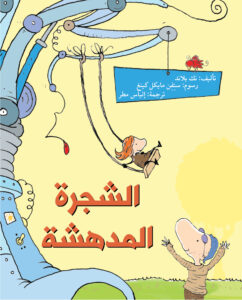 The Amazing Tree
The Amazing Tree 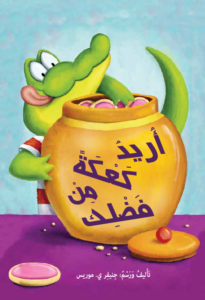 May I please have a cookie
May I please have a cookie 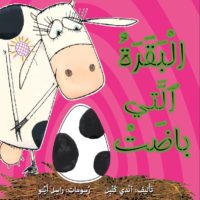 The Cow That Laid an Egg
The Cow That Laid an Egg 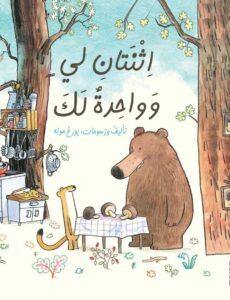 Two for Me, One for You
Two for Me, One for You 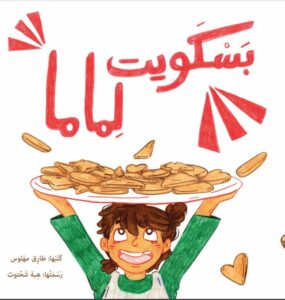 A Biscuit for Mama
A Biscuit for Mama 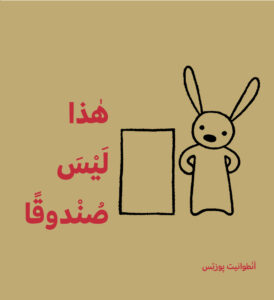 Not a Box
Not a Box 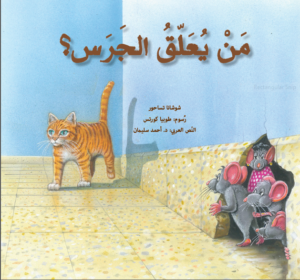 Who Will Hang the Bell
Who Will Hang the Bell 
